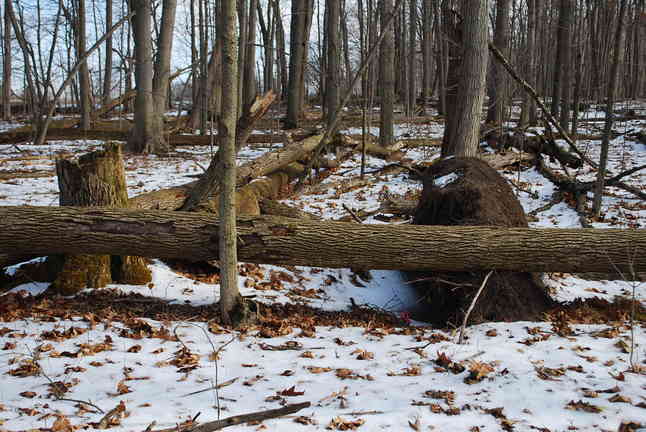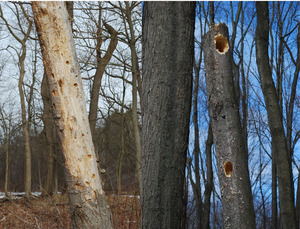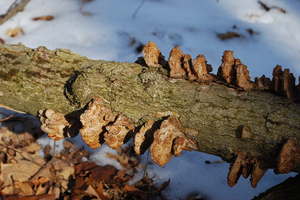The life of a dead tree - plant 'bones' shelter animals, improve ground water even after death

Lefurge Woods, a preserve of the Southeast Michigan Land Conservancy, is a beautiful, mature woods that has fallen trees, and some pit and mound topography, as shown here. Try to visit it - you'll be glad you did.
Rick Meader | Contributor
And, once a tree dies, especially a showy maple, a stately oak, or a towering elm, we mourn its passing. The thing is, ecologically speaking, a good chunk of that stately oak’s work has yet to be done when it has breathed its last “breath.”
In its “living life,” trees provide much more than beauty and shade. They create oxygen for the atmosphere, they loosen the soil with their roots (some even add nitrogen to the soil via nodes on their roots), and they intercept and absorb rain water that might otherwise run off of impervious surfaces below and damage our streams.
Aside from these direct functions, they provide perches, cover and nesting spots for birds, and countless insects and even cute, chubby squirrels. They slow down howling winds. They serve as feeding grounds, for animals eating the berries, acorns and seeds produced by the trees, and for animals eating other animals living or eating on the tree. If you look close, a living tree has a lot of activity on it beyond the rustling leaves and swaying branches.
Once a tree has died, its “bones” do even more to benefit future generations of living things, aside from providing firewood to keep us warm at home, or around a campfire.
If you go into a mature forest, you’re likely to see a number of things that you don’t see in a typical, manicured landscape. First, you’re likely to see some dead, standing trees, some fairly intact and some with holes drilled by woodpeckers (some of which are big enough to be used by woodpecker or other cavity-dwelling birds or other animals). Dead trees (especially those that still have their smaller branches) continue to provide perches for many birds and homes for many insects.
Other dead trees are a shell of themselves, broken off at the top, with bark gone and holes everywhere, home to boring insects and, as a result, they are woodpecker cafeteria lines.

Woodpeckers like dead trees, and they help to preserve living trees by pecking out larvae under their bark.
Rick Meader | Contributor
Another thing you’re likely to see in a mature forest is fallen trees in a range of condition, from fairly fresh, recently-downed trees to logs in varying states of decay, some sporting a variety of interesting fungi. Really old forests may even have rises of broken down woody material, often moss-covered. These are all illustrations of natural recycling — a tree falls and fungi, insects and bacteria all gang up on the fallen giant to reduce it to fertilizer for future trees and other plants. The logs also soak up rain water, aiding the decomposition process.
Before they’re gone completely, however, small mammals, salamanders, centipedes and other insects and arthropods make this cool, moist haven their home — the cover and insulation is welcome and even necessary relief on hot dry days in summer and cold, windy days in winter. Underground, the roots will also slowly decay, enriching the soil beneath the surface and increasing the soil’s water retention capacity as well.
An unappreciated benefit of a fallen tree is its impact on rain water and the health of our groundwater and streams. In our built landscapes, we create smooth, sloping lawns that are sure to carry water away from built structures, often to storm sewers, either in the yard itself or in adjacent streets. This protects the structures, and prevents, for the most part, wet spots that are difficult to mow and keep neat-looking, but it doesn’t do much for our groundwater supply. When we create these sloping, sewered, manicured lawns, we interrupt rain water’s natural downward flow into the soil in favor of a more efficient, speedy, flow of water across our landscape and into storm sewers which are directed, unfiltered, to a stream or river that is dependent on a slower, steadier flow of water.

Interesting fungi are fun to look at, and help to break down fallen logs.
Rick Meader | Contributor
In a mature forest, fallen trees, if their root system comes up when they fall, create holes in the earth that lead to what is known as “pit and mound” topography in a mature forest. In a well-manicured landscape, if a tree tips over bringing its root ball with it, we scurry to remove the tree and fill in the hole, making it nice and level. In mature woods, the hole is a natural reservoir, trapping rain water that finds its way there until it can seep down into the ground. Nature is not smooth. Nature has bumps and depressions.
Rain gardens are basically man-made replacements for the natural undulations in the earth that trap water, but which we level off in search of a “picture perfect” lawn. They’re usually much more showy by design, and the root systems of the plants used help to increase the rate of infiltration, but their function is to replace what is lost when we develop a site, in a manner similar to the pit and mound topography in forests.
So, what is this entry really all about? It’s an appeal to landowners everywhere. For the sake of our streams, birds, insects, amphibians, fish, crayfish and countless other creatures, don’t manicure every bit of your available land.
Plant clusters of native deciduous trees and allow the leaves and litter to lay around them to follow nature’s course and slowly disintegrate — protecting small creatures and slowing down rain water in the process. If a tree dies, cut off the top if you must for public safety reasons, but leave a good section of the trunk standing to private food, perches and homes for wildlife on your site. If you have an area with a bit of a depression, don’t fill it in and level it. Animals, our natural water supply and even our senses will benefit from even relatively small areas, and less maintenance will be required.
If you don’t have a tree that has fallen on your property, put a few logs down in whatever fashion/design you like, but let them be; let grasses and other native plants grow up around them. You can still have lawn, but by having at least some area of unmowed, treed and “logged” terrain, you’ll provide a real benefit. If you can provide an unmowed linkage to other unmanicured areas, so much the better, as it will provide passage ways for the animals seeking refuge under your logs. If you lay it down, the critters will come!
In this, a much more normal March than last year’s, even with the snow and cold, some buds are starting to swell. There is still time to get out and find the bumps, and thorns, and buds we talked about last time, and I encourage you all to get out and enjoy a wintry nature!
Also, a little plug here. On April 9 I'll be speaking at one of the Stewardship Network's events entitled "Making Your Landscape More Native" from 7-8:30 p.m.. If you'd like to hear me prattle on about how you can work with your own yard to make it a more native experience, you can find more information at the Stewardship Network site. I hope some of you can make it.
Rick Meader is a local landscape architect whose firm, Ecological Edge LLC, specializes in creating designs for homes, businesses and even churches that include a lot of native plants (and the wildlife they attract). You can contact him at ecologicaledgellc@yahoo.com.


Comments
Rork Kuick
Tue, Mar 19, 2013 : 8:03 p.m.
Outstanding. Thankyou. I have always left lots of logs just lay there or dead trees stand there. I'm responsible for lots of salamanders, and pileated woodpeckers and such. Also, the point about trying to keep corridors to connect the woods on either side of my own land was very good ("passage ways"). I may be decreasing my "lawn" soon too.